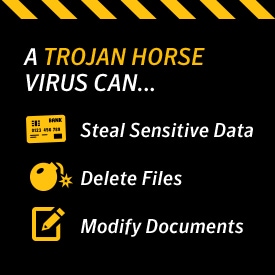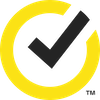What is a Trojan?
Borrowed from the story of the wooden horse used to trick the defenders of Troy into sneaking soldiers into their city, a Trojan Horse hides malware in what appears to be a normal file.

What is a Trojan Horse? Borrowed from the story of the wooden horse used to trick the defenders of Troy into sneaking soldiers into their city, a Trojan Horse hides malware in what appears to be a normal file. There are a wide variety of Trojan viruses on the Internet landscape that can perform an array of tasks. Most Trojans are typically aimed at taking control of a user’s computer, stealing data and inserting more malware on to a victim’s computer.

Help protect your digital life on your devices.
Are you afraid of losing your personal information or all the precious things on your computer? Get comprehensive protection with Norton Security Deluxe across all your devices – up to 5 PCs, Macs, smartphones or tablets.
Create an account today and try it free for 30 days on up to 5 of your devices.

These are some of the most common:
- Backdoor Trojan - These Trojans can create a “backdoor” on a users’ computer, allowing the attacker access to the machine in order to control it, upload stolen data and even download more malware onto the computer.
- Downloader Trojan - The main purpose of these Trojans are to download additional content onto the infected computer, such as additional pieces of malware.
- Infostealer Trojan - This Trojan’s main objective is to steal data from the infected computer.
- Remote Access Trojan - This Trojan is designed to give the attacker full control over the computer.
- Distributed Denial of Service (DDoS) Attack Trojan - This Trojan performs DDoS attacks, which are designed to take down a network by flooding it with traffic.
Trojanized apps
Trojans aren’t just problems for laptop and desktop machines. They can also impact your mobile devices as well. Generally speaking, a Trojan comes attached to what looks like a legitimate program, however, it is actually a fake version of the app, loaded up with malware. These cybercriminals will usually place them on unofficial and pirate app markets for unsuspecting users to download. In addition to the threats mentioned above, these apps can also steal information from your device, and generate revenue by sending premium SMS texts.
How to Stay Protected:
- Computer security must begin with an Internet security suite. Run periodic diagnostic scans with your software. You can set it up so the program runs scans automatically during regular intervals.
- Update your operating system’s software as soon as the updates are available from the software company. These groups tend to exploit security holes in outdated software programs. In addition to operating system updates, you should also check for updates on other software that you use on your computer as well.
- Don’t visit unsafe websites. Most Internet security suites include a component alerting you that the site you’re about to visit is unsafe.
- Don’t download attachments or click on links in unfamiliar emails.
- Protect accounts with complex, unique passwords.
- Finally, you should always keep your personal information safe with firewalls.
Editorial note: Our articles provide educational information for you. Our offerings may not cover or protect against every type of crime, fraud, or threat we write about. Our goal is to increase awareness about Cyber Safety. Please review complete Terms during enrollment or setup. Remember that no one can prevent all identity theft or cybercrime, and that LifeLock does not monitor all transactions at all businesses. The Norton and LifeLock brands are part of Gen Digital Inc.





Want more?
Follow us for all the latest news, tips and updates.